
Life saving tips to keep your pets safe as summer temperatures soar

(Image credits: ASPCA / Facebook)
As many areas across the U.S. continue to experience historically high temperatures this summer, the American Society for the Prevention of Cruelty to Animals (ASPCA) is reminding pet owners that hot weather conditions can be particularly dangerous for pets. With temperatures expected to be above average throughout the summer, the ASPCA is providing the below safety tips to keep our beloved fur babies happy and healthy over the next few months.
“It’s critical for pet owners to be prepared in cases of extreme heat, and we urge them to take the necessary steps to protect their pets as temperatures may rise across the country,” said Susan Anderson, Director of Disaster Response for the ASPCA National Field Response team.
“Remembering to provide fresh water, keep pets indoors, and monitor for signs of heat exhaustion are three simple ways to ensure their health and wellbeing during the hot summer months.”
To help prevent warm weather dangers from impacting your pet’s health, the ASPCA advises pet owners to remember the following safety tips:
- Pets can get dehydrated quickly so it is important to make sure they always have access to fresh, clean water, a shady spot to get out of the sun, and a cool, indoor area when the weather is too hot to be outside.
- If air conditioning is unavailable, add ice to water bowls and give pets frozen treats like dog ice cream, frozen broth popsicles, chilled cucumbers, or frozen food toys to keep them cool and occupied while indoors. Place a fan in front of a pan of ice to generate cooler air, provide them with wet, cool towels to lie on, or sponge cold water on their feet, abdomen and under their legs.
- Never leave animals alone in a parked car. A car can overheat even when the window has been left cracked open. Not only can it lead to a fatal heat stroke, it is illegal in many states.
- When the temperature is very high, don’t let pets linger on asphalt, sand, or other hot surfaces. Being so close to the ground, their bodies can heat up quickly, and sensitive paw pads can burn. Keep walks during these times to a minimum.
- It’s vital to recognize the signs and symptoms of heat stroke, which include excessive panting or difficulty breathing, increased heart and respiratory rate, drooling, mild weakness, stupor or even collapse. Symptoms can also include seizures, bloody diarrhea, and vomit along with an elevated body temperature of over 104 degrees. If your pet is experiencing any of these issues, contact your local veterinarian immediately.
For more information on how to safeguard your pet’s health during these hot summer months, see the video below.
(Source: ASPCA)
Posted by Richard Webster, Ace News Today / Follow Richard on Facebook and Twitter








 Use this list to ensure that you and your furry friends are prepared:
Use this list to ensure that you and your furry friends are prepared: